 |
|
|||
|
|
||||
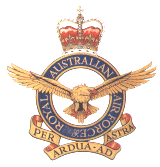 |
RAAF aircraft of World War Two Page 2
These are some of the aircraft used by the Royal Australian Air Force in WW2. They are the models that RAAF had in small or tiny numbers. Those models flown by RAAF in large numbers and very important models like Avro Lancaster all have a page of their own. These are the others. That does not indicate poor quality, just that RAAF did not have a lot of them. |
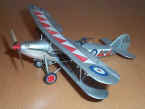 |
Hawker Demon The Hawker Demon first flew in February 1933. Australia enduring an economic depression in the 1920s and '30s delayed plans to expand the Royal Australian Air Force, but in January 1934 an initial delivery of 18 Hawker Demon two-seat fighter bombers arrived to replace the Westland Wapitis of 1 and 3 Squadrons. Other squadrons were subsequently equipped with a total of 54 Demon I and ten Demon II aircraft. |
 |
Junkers G31 In 1919, Junkers of Germany produced the world's first successful all-metal transport aeroplane, the Junkers F13. An improved version, the Junkers W34, appeared in 1926 and a further development was the Junkers G31 with three 525 hp Hornet engines. The G31 was primarily a passenger aircraft, but four aircraft were modified as freight carriers for New Guinea operations. In March 1942, as the Japanese advanced towards New Guinea, several Junkers aircraft were destroyed by enemy action and the RAAF impressed three others from Guinea Airways. |
 |
Lockheed P-38 Lightning The Lightning was designed in 1937 as a high-altitude interceptor. The first one built, the XP-38, made its public debut on February 11, 1939 by flying from California to New York in seven hours. Because of its unorthodox design, the airplane experienced "growing pains" and it required several years to perfect it for combat. Late in 1942, it went into large-scale operations during the North African campaign where the German Luftwaffe named it "Der Gabelschwanz Teufel" -- "The Forked-Tail Devil." Equipped with droppable fuel tanks under its wings, the P-38 was used extensively as a long-range escort fighter and saw action in practically every major combat area of the world. A very versatile aircraft, the Lightning was also used for dive bombing, level bombing, ground strafing and photo reconnaissance missions. By the end of production in 1945, 9,923 P-38s had been built. |
 |
Lockheed Lodestar The Lockheed Model 18, or Lodestar, was built as a civilian airliner in 1940 and was developed from the Model 10 Electra, the Model 12, the Model 14 Super Electra and the unbuilt Model 16. The Lodestar, in turn, was the forerunner of the Lockheed Ventura. 10 Lodestars were allotted to No 37 Sqn RAAF, and later to Nos 1 and 4 Communications Units. On January 26 1945, A67-6 crashed and burnt, but the remaining nine Lodestars gave good service until they were sold to civilian operators in 1947. In addition, five Lodestars (LT 931/935) were transferred from NEI to No 37 Sqn early in 1944. |
 |
Lockheed Ventura Between May 18 and August 19 1943, 20 Venturas were lend-leased to the RAAF. Also, between June 23 1943 and July 2 1944, 55 PV-1s were lend-leased under the RAAF. The Ventura Mk II was heavier and more powerful than the Mk I, whilst the Ventura GR 5 had extra long-range tanks, and some versions were fitted with the Mk IV nose radar. The Venturas operated with No 13 Sqn mainly, but several also served with Nos 4 and 11 Communications Units. |
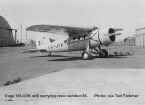 |
Lockheed Vega Just one example of this famous high speed light transport served in RAAF colours, being impressed for service from its civilian operator MacRobertson Miller Aviation in November, 1942 as A42-1. Although it served with 24 and 33 Squadrons, as well as 3 Communications Unit, it only logged 46 flying hours before being scrapped in October, 1945. |
 |
Martin PBM Mariner Late in 1943, 12 Martin Mariners (PBM-3R versions) were lend-leased to the RAAF. These transport flying boats were delivered without armament or search radar, and were modified for personnel and freight tasks. They provided long-range support for the RAAF during the island hopping campaigns against the Japanese. The Mariners operated in conjunction with the Sunderlands of No 40 Sqn, and they superseded the Empire Flying Boats and Dorniers in No 41 Sqn. |
 |
Miles Magister Ordered in quantity by the RAF, only one Magister served in RAAF colours and was purchased for comparison with the Tiger Moth and the CAC Wackett. The sole representative of its type served with No.1 Flight Training School at Point Cook, from May 1940 and was transferred to the Engineering School in July that year. It was converted to components later that same month |
 |
Noorduyn Norseman The Canadian Noorduyn company designed and built the Norseman in the 1930s as a rugged bush utility transport. Fourteen of these 10 seat aircraft were supplied to the RAAF in late 1943 and served with Nos 1 (at Essendon), 2 (Mascot), 4 (Archerfield), 5 (Garbutt) and 7 (Pearce) Communications Units. By the war's end six had been written off or reduced to components, and the remainder were sold to civilian operators between 1947 and 1950. |
 |
Northrop Delta In February 1939, on conclusion of his fourth Antarctic expedition, the famous explorer, Lincoln Ellesworth, sold his ship, the "Wyatt Earp", to the Australian Government. The sale included two aircraft, a Northrop Delta 1-D (ex NR-14267), and an Aeronca Model K Seaplane (ex NC-18888). In 1940, the Delta was registered as VH-ADR, and was used by DCA for checking navigational aids. In December 1942, VH-ADR was impressed by the RAAF as A61-1, and was issued to No 35 Sqn. Six months later, the Delta was transferred to No 34 Sqn and later to No 37 Sqn. On September 30 1943, the aircraft swung on take-off, apparently due to the collapse of the tail wheel strut. The Delta was damaged beyond repair and was dismantled in 1944 |
| Republic P-43 Lancer In 1942 eight Lancers were delivered to the RAAF to augment the Buffaloes and Lightnings of the Photographic Reconnaissance Unit. Six of the aircraft, were received on August 31 1942, and the remaining two arrived on 10th November 1942. The Lancers operated with PRU until the following year when A56-1, 2, 3, 4, 5 and 8 were transferred to the US 5th Air Force at Charters Towers. Of the remaining two Lancers, A56-6 was taken off strength on 8th March 1943, and at the time, A56-7 was officially listed as "Missing. Aircraft left Wagga on 28th April 1943, and has not been sighted since". This mystery was solved 15 years later when Lancer A56-7 was located in 1958 in the Healesville Hills, north-east of Melbourne. | |

(photo: Brian Thomas) |
Ryan STM Thirty-four Ryan STMs were absorbed into the RAAF, and the first aircraft, A50-1, was received on July 21 1942 and the last, A50-34, on August 27 1942. The Ryans were used mainly for refresher training at BAG, WAG and OAS units, whilst others were flown on transport missions with Nos 1, 2 and 3 Communications Units. Also, at least one float-plane version operated for a short time from RAAF Rathmines. |
 |
Short
Sunderland The prototype Short
Sunderland flying-boat first flew on October 16 1937, and nine Mk I
versions were ordered for the RAAF under the A18 designation. However,
when No 10 Squadron accepted the first aircraft, P9048, at Pembroke Dock
on September 11 1939, the Sqn remained in the UK with RAF serialled
Sunderlands, and was later joined by No 461 Sqn. From the first
confirmed submarine "kill" by Flt Lt W. N. Gibson's crew on
July 1 1940, the two squadrons destroyed
almost a dozen U-boats. No.10 Sqn
also introduced many modifications, including increased defensive
armament, and the installation of Pratt and Whitney Twin Wasps, which
resulted in the Sunderland Mk V. Not to be outdone, No 461 Sqn safely
landed the first Sunderland on an airfield (through necessity), looped
another (somewhat inadvertently) and, on July 2 1943, Flt Lt Walker in
N461 engaged eight JU88s, claiming three destroyed, one probable, one
possible, and damage to the other three.
Thus, in 1944, when six Sunderland Mk IIIs (ML730 to ML734, and DP192) were flown from No 10 Sqn to the Pacific, the flying-boats were well known to Australians. By this time the A18 serials were redundant, as the last Short Empire flying-boat had been returned to Qantas in 1943, so the Sunderlands were renumbered A26-1 to A26-6 respectively. The aircraft operated with No 40 Sqn on transport duties, and on November 28 1944, A26-6 was severely damaged at Townsville. The remaining five Sunderlands were sold to B. Monkton in 1947, and at least two (VH-AKO ex A26-4, and VH-AKP ex A26-5) were modified and registered with DCA (Department of Civil Aviation) as Short S25 Hythe flying-boats. |
 |
Short Empire During 1939/40, the RAAF impressed (from QANTAS Empire Airlines) four S23s as follows: "Centaurus"; "Calypso"; "Coogee"; "Coolangatta". "Coogee" was written off in a landing accident at Townsville on February 27 1942, and a few days later, on March 3 1942, "Centaurus" was destroyed during a Japanese air-raid on Broome. Consequently, a fifth flying-boat, "Clifton", was impressed on March 9 1942. This aircraft was a S33, being a hybrid with a strengthened hull for a payload of 53,000 lb. On August 8 1942 "Calypso" was destroyed at Daru, New Guinea, but both "Coolangatta" and "Clifton" carried out many successful missions and were eventually returned to Qantas in July, 1943. During RAAF service, the flying-boats operated with Nos 11, 20, 33 and 42 Squadrons in the transport and medevac roles. |
 |
Stinson Reliant Only one Stinson Reliant served with the RAAF, A38-1, being impressed into service on 24th February, 1941. After use as a VIP and general transport by No 2 Communications Flight and No. 2 Communications Unit it was transferred to the Department of Civil Aviation on 4th May, 1945. |
 |
Supermarine
Walrus Designed specifically for
use on RAN cruisers as a catapult launch craft, the first Seagull (know
as the Walrus in British service) was first flown in June 1933. 24
aircraft were originally ordered for Australian service. Of these
aircraft eleven were lost, including nine in crashes and two due to
enemy action, (one from HMAS Sydney and A2-2 issued to HMNZS Achilles).
A further 37 machines were delivered to the RAAF during World War 2 and
these aircraft retained their British serial numbers.
In 1947, Walrus HD874 joined the tank landing ship HMAS Labuan for the first Antarctic expedition since World War 2. The amphibian was wrecked in a gale at Heard Island on 5th January, 1948 and lay there for forty years until recovered and brought to Point Cook for restoration to display condition. The aircraft rejoiced in two nicknames; "Shagbat" and "Steam Pigeon". |
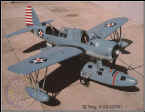 |
Vought-Sikorsky
Kingfisher The aircraft became
known as the Kingfisher and could be operated as a land-plane or
single-float seaplane, although it was used mainly in the latter
configuration. As well as carrying out reconnaissance patrols from
coastal bases and catapult-equipped ships, the Kingfishers were also
used for rescue operations. On one
memorable occasion in 1942, a Kingfisher pilot taxied 40 miles through
rough seas to rescue Capt Eddie Rickenbacker who had been lost in the
South Pacific.
In April 1942, eighteen Kingfisher seaplanes were shipped to Australia and assembled at RAAF Rathmines as A48-1 to A48-18. After a working-up period, the Kingfishers were allocated to No 107 Sqn which was formed at Rathmines on May 10 1943. At the time, enemy submarines were operating in Australian waters and the Kingfishers carried out numerous patrols and attacks and recorded a "probable damage" against a German U-boat. Unfortunately, the Kingfisher bore a marked resemblance to the Japanese Rufe seaplane and many of the squadron's early sorties were carried out against gunfire from both friend and foe. The Kingfishers later operated from St. George's Basin, and the squadron was eventually disbanded on October 31 1945, when most of the aircraft were phased out of service. In 1947, Sqn Ldr R. Gray operated Kingfisher A48-13 from HMAS Wyatt Earp during the first of the post-war Antarctic expeditions. |
 |
Wackett Gannet
Upon disbandment of the RAAF
Experimental Station in 1930, Wg Cdr Wackett left the Service and
designed the twin-engined Codock airliner for Sir Charles
Kingsford-Smith. Tested in April 1934, the Codock was the forerunner of
the Gannet which was Wackett's seventh aircraft design. The first two
RAAF aircraft were produced by the Tugan Aircraft Co, and were
officially designated LJW7 Gannets. This company was subsequently
absorbed into CAC, and from 1936 the aircraft became known as Wackett
Gannets.
The first Gannet was received in November 1935, and until 1941 the Gannets operated with photographic and survey Units. As from A14-3, Gannets appeared with inset auxiliary fins for improved rudder and aileron control. Early in 1942, the remaining Gannets were converted to air ambulances and operated with the newly-formed No 2 Ambulance Unit. |
 |
Waco YQC-6 On August 4 1942, the RAAF impressed Waco YQC-6, ex VH-UVW, and the aircraft was taken on strength at No 3 Communications Flight as A54-1. The following day, it was allotted to Marshall Airways for camouflaging and modification, and was returned to No 3 Communications Flight on August 26 1942. On September 6 1942, the Waco ground-looped on landing and the starboard lower main-plane and both spars were broken. The aircraft was subsequently repaired and over-hauled, and continued to give good service at No 3 Communications Flight until April 12 1944, when it was allotted to No 2 CRD. On November 26 1944, the Waco was offered for disposal |
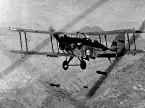 |
Westland Wapiti Between the wars the Wapitis served with Nos 1 and 3 Squadrons, Central Flying School and other units, but front line service effectively ended in 1935 with the arrival of the Hawker Demon, and the Wapiti was relegated to the training role including service with 1 Flying Training School. The types service was extended with the purchase of six ex-RAF machines in 1937. |
-
More precise detail can be obtained from RAAF Museum Research section
